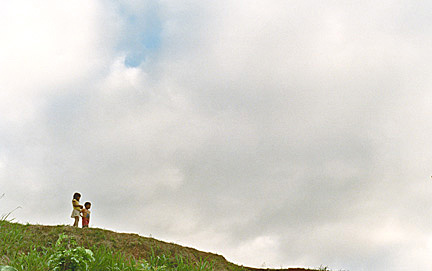New homes.
I will be creating four individual posts with journal entries, a story or two and photos specific to each person or organization that received the money.
That’s real soon. Today’s June 6. So bear with me.
In the meantime, here is a synopsis.
NUEVA ESPERANZA – This tiny village of 194 people sits perched atop a red-bank cliff on the remote Yavari River in the Amazon rainforest of Peru. It is a day’s boat ride from another community and two days to one that has a store, lodging or any other services. Brazil, and logging concessions, are across the river.
As part of a volunteer group with researchers, we visited the community to help with the wildlife management program and to help launch a health initiative. The scientists are helping the residents hunt monkeys, wild pigs, game birds and other animals sustainably and want to provide better medical training and better sanitation. Malaria is a huge problem here. The homes are simple, with holes cut in the wood for windows. There’s a nurse’s station, but having a nurse practitioner there or medications there is hit or miss. For $300, we have paid for the installation of screens on all the homes in Nueva Esperanza. Come dusk, most families stay inside and this will protect them.
My friend Pablo Puertas, a researcher who specializes in community work, is organzing this now that i’m gone. A carpenter will install the screens in July and sent along photos.

BELEN
Iquitos is the largest city in the world that’s accessible only by plane or boat. It is in the Peruvian Amazon, and the hub for the region. More than 7,000 people live in Belen, a slum on the western side. In flood season, the river gets as high as the stilts the wooden homes are built on. The water is their bath, their swimming hole, their washing pit, their garbage and their latrine.
When the flood waters recede, what isn’t washed away stays behind in the muck. The city’s poorest are here, traveling in canoes and on elevated wooden walkways between homes, stores, churches and schools and the crowded Belen market. You can find anything here from carved up 8-foot caimans to medicinal plants and hand-rolled cigarettes. Schools are free, but children must bring their own supplies.
At the Instititucion Educativa Primaria Secundaria de Menores, says Principal Lilia Coral Puertal, that often means that they come empty handed. Parents often can’t afford to feed their families. With $90, hit a local “libreria” and bought 100 notebooks, pens, pencils, sharpeners, colored pencils and other supplies – enough to outfit 48 kids for some time.
Lilia said another traveler had visited there a month earlier and brought backpacks. “It is truly a blessing,” she said.

Tags: Amazon, malaria, Peru, Travel, villages

翻译公司
It’s been said before, but I think it’s worth repeating. I think it’s incredible that you make such a difference in people’s lives on such a shoestring budget. So many of us, with so much greater resources at our disposal, never really “get around” to helping humanity. Things we take for granted: screens on the windows, pencils and paper for schoolkids; these are the things you’ve brought to people who truly needed them, so far away!
I’m proud to have donated to your project last time (even though I couldn’t spare as much as I wanted), and I’ll keep doing it every time you can make a trip. More importantly, I’m proud to know you. You’re a real inspiration and model.
Cheers!
翻译公司